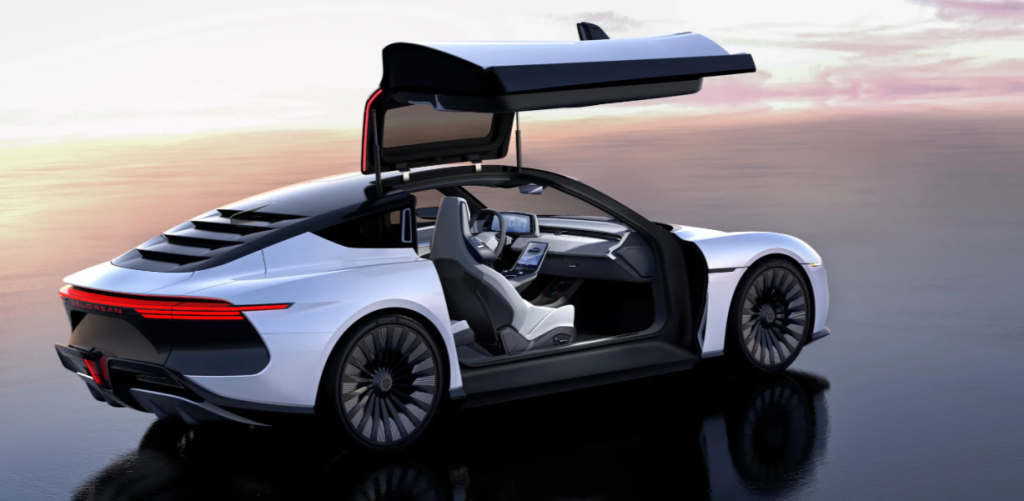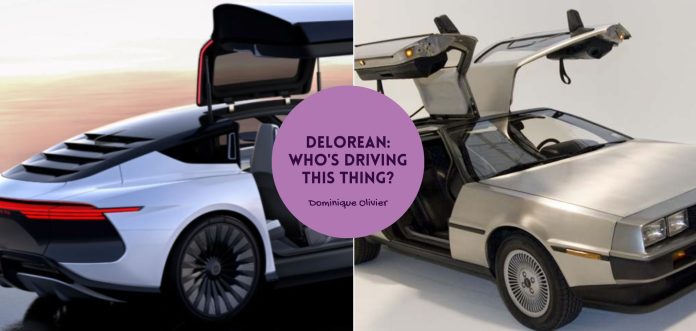Gullwing doors, fairy curses, cocaine busts and sneaky accounts in Panama. As it turns out, being the world’s most recognisable time machine isn’t even the most interesting part of the DeLorean story. Buckle up, dear reader, because we’re taking a little drive down memory lane – and where we’re going, we don’t need roads.
There was a bit of a fistfight going on in the automotive industry a while ago, and you’ll never guess why. Blame it on retro-nostalgia: not one, but two designs for a modern take on the famous DeLorean were doing the rounds on social media in 2022, getting petrolheads whipped into a frenzy of excitement.
One design was being punted by the DeLorean Motor Company, which bought the right to use the name from John DeLorean after he declared bankruptcy in the late 90s:

The other was championed by Kat DeLorean – John DeLorean’s eldest daughter:

And neither one of these parties wants the other to build their car.
Legal action was threatened in both directions in the early part of 2024, and the stage was quickly set for what looked like a meaty court battle over the DeLorean legacy. And then… crickets. The concept cars have remained concepts, CEOs have come and gone, and die-hard DeLorean fans have been left waiting and wondering if they’ll ever have a chance to buy either car (rumour has it 2025 might be the year).
Then again, real DeLorean fans know that empty promises are as much a part of this car as its iconic gullwing doors.
Let’s start with the man behind the name
John Z. DeLorean was born in Detroit, Michigan in 1925. The eldest of four children, John showed promise early on and was accepted into Cass Technical High School, a school for Detroit honour students, where he signed up for the electrical curriculum. His academic record and musical talents earned him a scholarship at Lawrence Institute of Technology in Highland Park, the alma mater of some of the automobile industry’s best engineers.
Following a number of interruptions – including being drafted into the army during WWII and then moonlighting as a life insurance salesman for a few years – John eventually attended the Chrysler Institute of Engineering. He graduated with a master’s degree in Automotive Engineering and joined Chrysler’s engineering team.
But he didn’t stay at Chrysler for long. After less than a year, John traded Chrysler for Packard Motor Company, and before long he was headhunted from there straight into General Motors. Given his choice of a job in any of GM’s five divisions, John chose Pontiac and made a name for himself by developing cars such as the Pontiac GTO, the Firebird and the Pontiac Grand Prix. His next promotion saw him receive the keys to the Chevrolet castle, and by 1972, he was appointed to the position of vice president of car and truck production for the entire General Motors line.
John seemingly had everything going for him. He was ambitious, intelligent, and his non-conformist style of doing business made people sit up and listen to what he had to say. Everything he touched seemed to turn to gold. But just when it seemed like the top position of GM president was within his reach, he did the unthinkable. He turned his back on GM and went off to start his own business: DeLorean Motor Company.
The long and bumpy road
In the mid-1970s, John DeLorean unveiled his vision for the future of sports cars: the DeLorean Safety Vehicle (DSV), a two-seater prototype with a bodyshell designed by none other than Giorgetto Giugiaro of Italdesign fame. The car would eventually shed its “Safety Vehicle” moniker and emerge as the mononomic DeLorean, complete with its unmistakable unpainted stainless steel body and those gullwing doors that looked like they were borrowed straight from a sci-fi movie. Under the hood sat the “Douvrin” V6 engine, a joint creation of Peugeot, Renault, and Volvo, also known as the PRV.
To bring this steely dream to life, a manufacturing plant sprouted up in Dunmurry, a Belfast suburb, bankrolled by a cool £100 million from the Northern Ireland Development Agency. Renault built the factory, Lotus fine-tuned the chassis and bodywork, and at its peak, over 2,000 workers were churning out cars. The factory went on to produce just over 9,000 DeLoreans, though not without a hefty amount of production delays along the way.

When the DeLorean finally hit the streets in January 1981 – nearly a decade after its inception – it landed with what can only be described as a thud. The timing couldn’t have been worse: the US economy was in a nosedive, and consumers weren’t exactly itching to drop serious cash on a sports car. Even the super-rich were unconvinced. American Express tried to cajole the 1% with an ad for limited-edition DeLoreans plated in 24-carat gold, priced at $85,000 a pop – or around $340,000 in today’s money, which is roughly the current price of a new mid-range Ferrari. The pitch was that only 100 would ever be made. The reality was that only four were sold.
Critics weren’t kind, either. Sure, the doors turned heads, but the steep price and underwhelming horsepower left most cold. By early 1982, the wheels were really starting to come off. More than half of the DeLoreans produced were gathering dust in showrooms, DMC was drowning in $175 million of debt, and the Dunmurry factory was placed in receivership.
In January 1982, the British government uncovered what someone had been trying very hard to hide. Despite producing just 8,500 cars, a staggering £23 million – nearly half the funds allocated to DeLorean back in 1974 – had mysteriously detoured into a Panamanian account under the name “General Product Development Services”. This shell company was allegedly set up to funnel money to Lotus, whose mastermind, Colin Chapman, had helped develop the DeLorean. But the cash never made it to Lotus, and Chapman himself happened to pass away just as investigators started following the money trail. Odd timing, right?
After DMC went into receivership in February 1982, the factory squeezed out another 2,000 cars, but the writing was on the wall. By late October, John DeLorean was arrested on unrelated charges (more on that later). Liquidation proceedings kicked off, and the British government finally seized the ill-fated Dunmurry factory.
According to the Irish locals, the factory was doomed from the start because John DeLorean allegedly destroyed a fairy fort during construction. If true, it’s a classic case of “mess with the fae, pay the price”. So, was it bad business decisions, financial misdeeds, or a vengeful fairy curse that tanked the DeLorean dream? Take your pick.
And then there was the whole cocaine thing
On October 19, 1982, John DeLorean was charged by the US government with trafficking cocaine. This followed a videotaped sting operation in which he was recorded by undercover federal agents while agreeing to bankroll a massive cocaine smuggling operation.
The operation’s spark came from James Timothy Hoffman, a former neighbour of DeLorean’s who turned FBI informant. Hoffman claimed DeLorean reached out to him about arranging the drug deal, but in reality, it was Hoffman who made the call. Why? Hoffman was facing his own cocaine trafficking charges and figured setting up DeLorean would win him a lighter sentence. Hoffman later admitted that he was aware of DeLorean’s financial troubles before he contacted him, and had heard him admit that he needed $17 million “in a hurry” to prevent DMC’s imminent insolvency.
At trial, DeLorean’s lawyers cried foul, arguing entrapment. They pointed out that Hoffman, a casual acquaintance at best, baited DeLorean into the scheme by preying on his financial woes, with the full backing of the FBI and DEA. The jury agreed, and on August 16, 1984, DeLorean was found not guilty. But by then, the damage was done – DMC was long bankrupt, and DeLorean’s reputation lay in tatters.
A year later, DeLorean faced new charges, this time for defrauding investors and committing tax evasion by allegedly siphoning millions meant for his company into his own pocket. Once again, he walked away acquitted, but by then, his rags-to-riches-to-scandal story was the only thing associated with the DeLorean name. When asked after his acquittal if he planned to resume his career in the auto industry, DeLorean bitterly quipped, “Would you buy a used car from me?”
The closing of the curtain
In 1985, the DeLorean roared back into the spotlight – not for its performance on the road (that was never going to happen), but for its performance on the big screen. Back to the Future transformed the stainless steel wonder into a bona fide cultural icon practically overnight. John DeLorean was so delighted that he wrote to the film’s writer and producer, Bob Gale, to personally thank him for immortalising the car. Talk about a silver lining for a tarnished legacy.
But while his car was traveling through time, DeLorean was stuck fighting his past. By 1999, after battling around 40 lawsuits in the aftermath of his company’s implosion, DeLorean filed for personal bankruptcy and sold the DeLorean Motor Company name to a Texas-based firm that provides parts and professional restoration to DeLorean owners. The fallout also forced him to sell his sprawling 434-acre estate in Bedminster, New Jersey. It was bought by Donald Trump and transformed into a golf course (of course).
DeLorean died from a stroke in 2005, at the age 80. His final years were spent dreaming up and designing a new vehicle, which he called the DMC2. His tombstone shows a depiction of a DeLorean with the gullwing doors open.
Legacy at the crossroads
As we stand at the start of 2025, the future of the DeLorean remains uncertain. The fanbase has responded positively to the idea of an updated car, but the IP battle to get it made promises to be a doozy.
On the one hand, the Texas firm that bought the rights to the name back in the 90s has kept the DeLorean Motor Company alive for two and a half decades. On the other hand, Kat DeLorean has lived with the DeLorean name and its consequences her whole life (she often jokes that the abbreviation DMC actually stands for Destroy My Childhood); she watched her father’s passion for an unsellable idea drag him and their family down to the point of bankruptcy, and she saw him carry dreams of its resurrection to his death. There’s somewhat of an emotional pull in the idea of her continuing the family legacy and righting the wrongs, so to speak.
All we know for sure at the moment is that there are two hands on the chalice and two parties vying to drink from it. Perhaps the biggest irony is that neither knows for sure whether it holds poison or wine.
Would you like to see a return of the DeLorean? And would it make a difference to you whether the car is coming from the daughter of the founder or an unrelated investor? Let us know in the comments!
About the author: Dominique Olivier

Dominique Olivier is the founder of human.writer, where she uses her love of storytelling and ideation to help brands solve problems.
She is a weekly columnist in Ghost Mail and collaborates with The Finance Ghost on Ghost Mail Weekender, a Sunday publication designed to help you be more interesting.
Dominique can be reached on LinkedIn here.





Loved the movies .. can’t say either way that the car is user-friendly enough for 2025!
As a young engineer in the early 80’s I read “On a clear day you can see General Motors”, de Lorean’s moan-and-groan against GM. It was a useful introduction to the spiderwebs of corporate executive culture. But its message was undercut by de Lorean’s subsequent scandalous history. One of hs major problems: not having dealerships willing to accept his car! Well, this book had shown what he thought of the industry so who would support him now? As it turns out, no one! The whole debacle was a?fascinating insight into the “other side” of engineering: not the great stuff of designing and building things; but the politics and financial ins and outs of the field. Thx for this great article